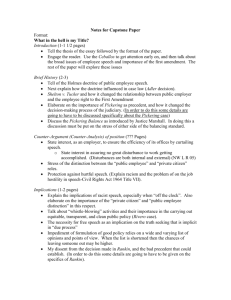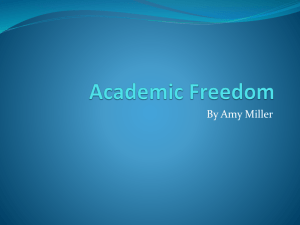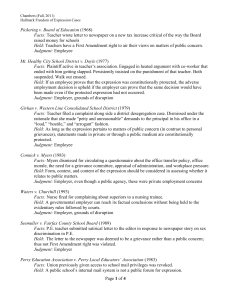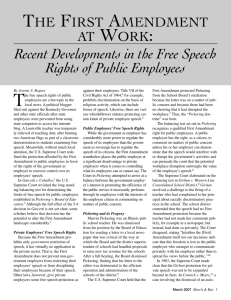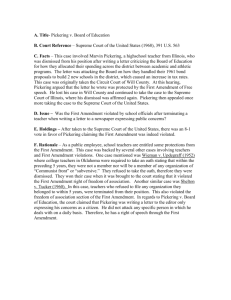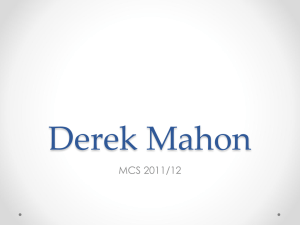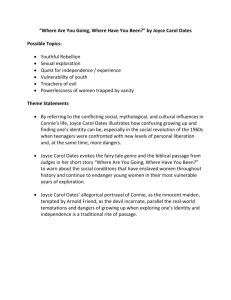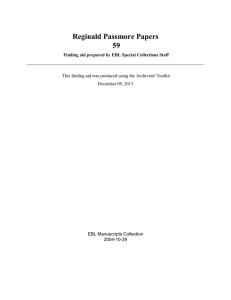biliography
advertisement
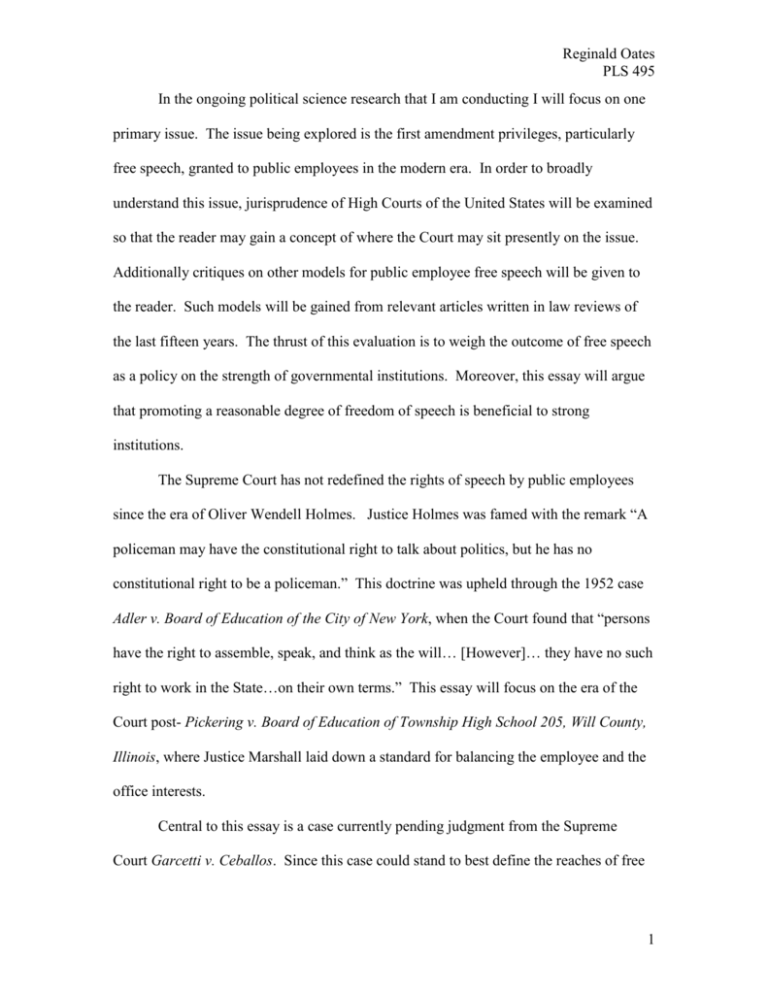
Reginald Oates PLS 495 In the ongoing political science research that I am conducting I will focus on one primary issue. The issue being explored is the first amendment privileges, particularly free speech, granted to public employees in the modern era. In order to broadly understand this issue, jurisprudence of High Courts of the United States will be examined so that the reader may gain a concept of where the Court may sit presently on the issue. Additionally critiques on other models for public employee free speech will be given to the reader. Such models will be gained from relevant articles written in law reviews of the last fifteen years. The thrust of this evaluation is to weigh the outcome of free speech as a policy on the strength of governmental institutions. Moreover, this essay will argue that promoting a reasonable degree of freedom of speech is beneficial to strong institutions. The Supreme Court has not redefined the rights of speech by public employees since the era of Oliver Wendell Holmes. Justice Holmes was famed with the remark “A policeman may have the constitutional right to talk about politics, but he has no constitutional right to be a policeman.” This doctrine was upheld through the 1952 case Adler v. Board of Education of the City of New York, when the Court found that “persons have the right to assemble, speak, and think as the will… [However]… they have no such right to work in the State…on their own terms.” This essay will focus on the era of the Court post- Pickering v. Board of Education of Township High School 205, Will County, Illinois, where Justice Marshall laid down a standard for balancing the employee and the office interests. Central to this essay is a case currently pending judgment from the Supreme Court Garcetti v. Ceballos. Since this case could stand to best define the reaches of free 1 Reginald Oates PLS 495 speech in this era of the Court, the arguments and case law from each side1 must be used so that the importance of the free speech may be weighed against government interest in curtailing that speech. Also, due to the timing of this piece relative to the decision being handed down, the central argument of this piece will be defended over the argument in support of greater government discretion to curtail speech of employees. The preliminary findings of the research agree with the balancing approach taken by Justice Marshall, which would be more favoring the employee over the office. Justice Marshall thought it important to weigh “the interests in the employee speech, as a citizen commenting on matters of public concern and the interest of the State, as an employer, in promoting efficiency of public service it performs through employees.” Though that is agreed upon, the distinction made between the employee as a citizen, and the employee as a member of government is disagreed with. This would tend to allow the State, as an employer, to allow less popular speech to be grounds for retaliation. What should be of more importance is the efficiency part of the balancing, and whether or not the speech is detrimental to the quality and speed of the task in which the State has mandated. 1 This includes the parties being heard by the Court as well as the arguments posed in selected amicus curiae briefs. 2 Reginald Oates PLS 495 Adler v. Board of Education. 1952. 72 S Ct. 380. This is used as an example of pre-Pickering jurisprudence of free speech cases involving public employees. The direction of the Court is easier to track when looking at the history of the subject. Adler is a great example of the pre-Pickering history. Amicus Brief Filed by the ACLU and National Association of Criminal Defense Lawyers. 2005. WL 1801033. This Brief is used to widen the arguments made in support of ending retaliation based on speech matters of public employees. It shows the importance for the criminal justice system, that employees may engage in speech without the fear of retaliation. Amicus Brief Filed by an Association of State and Local Governments. 2005. WL 1317483. This brief is used so that the writer may broaden the understanding that governments have a vested interest, as an employer, in the ability to regulate speech of its employees. Also, makes the argument that Ceballos engaged in his speech while acting in his official capacity. Brady v. Maryland. 1963. 83 S. Ct. 1194. Case used in Ceballos to show that the Fourteenth Amendment’s Due Process Clause made it necessary for the speech for which he was eventually punished. This makes an implication on the ability for government to carry out matters of criminal justice according to a doctrine of a “fair trial”, when speech is repressed. Brewster v. Board of Education. 1998. 149 F. 3d 971. The case addresses the issue of retaliation that includes salary deduction as well job dismissal. This case involves a teacher who felt that he was wrongly removed from his job for questioning the accuracy of attendance records. The lower court found that this was not a violation of his First Amendment rights. Connick v. Myers. 1983. 103 S. Ct. 1684. Similar case to Ceballos, in this an assistant district attorney was fired because of a poll she circulated around her office asking for other employees to rate their confidence in the leadership. The Supreme Court Voted five to four defending the termination of Myers. Garcetti v. Ceballos. 2003. 361 F. 3d 1168. This is the primary case which is being used to uphold the argument of this piece. A district attorney is demoted and threatened by superiors after submitting a memo to the defense in a case that was then pending. Contained in the memo was information about an officer, who perjured himself in a critical testimony. This memo was first offered to the District Attorney’s office with the recommendation that the case be dismissed, however this information was rejected. 3 Reginald Oates PLS 495 New York Times Co. v. United States. 1971. 91 S. Ct. 2140. A strange case stating that the government needs to meet a high burden of proof for the ability to stop the dissemination of materials. I’m still battling through this case to find out if it is worth keeping. This case ended up five to four in support of the government not meeting its burden of proof. There was, however, nine opinions filed by the justices and most of them were joint opinions. Pave, Margo. 1995. “Public Employees and the First Amendment Petition Clause: Protecting the Rights of Citizen-Employees Who File Legitimate Grievances and Lawsuit Against Their Government Employers.” Northwestern University Law Review. 90 N. W. U. L. Rev. 304. Review focuses on the use of the Petition clause of the First Amendment to assert the right for employees to assert their free speech. Pickering v. Board of Education. 1968. 88 S. Ct. 1731. Justice Marshall issued the opinion in this case that would dictate the balancing technique that would be used in the future in cases concerning free speech and public employees. Petitioners Reply Brief from Ceballos lower court ruling. 2005. 2005 WL 2072142. This reply from Garcetti et al. helps to understand the argument of the petitioners. Moreover, it is a good piece that the arguments of the same side are based. In my paper this serves as a good counter-argument to my thesis. Rankin v. MacPherson. 1987. 107 S. Ct. 2891. This is a case regarding public employee speech in which the employee MacPherson said that if someone comes again to try to shoot the president (R. Reagan) she hoped that they would get him. For this comment she was fired. The Court Agreed with a five to four vote that she should be reinstated. Riley, Elizabeth A. 1995. “Waters v. Churchill: The Procedural Due Process Disguise of Public Employee Free Speech Rights.” Capital University Law Review. 24 Cap. U. L. Rev. 893. Riley gives me a good overview of public employee speech rights through the view of Waters v. Churchill. Additionally she compares the speech rights of the public employee with that of the private employee. This article as well deals more with job dismissal than any other form of punishment. Rivero v. City of San Francisco. 2002. 316 F. 3d at 865. Case confronts whistle-blowing activities on the part of a government contractor. Also, it makes the statement that such activity, if carried out by an employee of the government would promote office inefficiency. It is unclear how the Court will regard this as precedent for either side, but it adds an interesting dimension to the discussion. 4 Reginald Oates PLS 495 Schoen, Rodric. 1999. “Pickering Plus Thirty Years: Public Employees and Free Speech.” Texas Tech Law Review. 30 Tex. Tech L. Rev. 5. An article that addresses cases in which speech is grounds for removal from public employment. It does not address other forms of punishment that jobs may inflict. However the article is useful when forming an opinion on whether or not job loss is a critical distinction when compared to other forms of employer dissent. Shelton v. Tucker. 1960. 81 S. Ct. 247. This is used to show how the Court established the right of public employees to not forcibly disclose group membership. Shelton shows that the right to speak freely logically follows the right of non-disclosure that was made evident through Shelton’s application of NAACP v. Alabama. Travieso, Andre G. 1999. “Employee Free Speech Rights in the Workplace: Balancing the First Amendment Against Racist Speech by Police Officers.” Rutgers Law Review. 51 Rutgers L. Review 1377. This article adds a new dimension to opinions on how speech should be regulated in the public workplace. Racist speech by an officer, while off-duty, was the basis of this article. This type of behavior has to be addressed in order to give a full argument for allowing speech rights to public employees. 5
